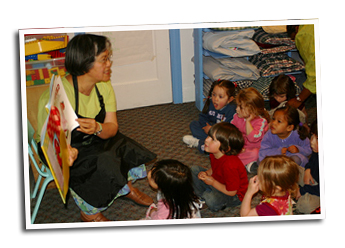Home | Supporting Dual Language Learners | Teacher Interactions and Strategies | Listening
Listening
The following interactions and strategies from the California Preschool Curriculum Framework, Volume 1, pp. 190-192, (CDE, 2010) support dual language learners in building listening skills:
Model good listening skills.
- Listen patiently.
- Make eye contact.
- Be at the child’s eye level.
- Provide positive verbal and nonverbal responses.
Use the home language for comprehension.
- Start with what the child knows.
- For children in the earliest stages of second language development, use common words in the home language to help the child connect concepts with the English labels.
Keep messages and directions short when working with dual language learners.
- Break directions into short steps.
- Model proper English.
- Use visual cues (e.g., photos, real objects or gestures) whenever possible.
Teach children how to listen, repeat messages, and ask questions.
- Establish listening cues such as a “freeze” signal.
- Provide active ways for dual language learners to respond to messages. For example, ask children to put their hands on their heads if they are going to dramatic play.
- Teach children to restate, repeat, summarize and reflect on classroom activities
Provide a listening library in the home language and in English.
Summarize or provide key phrases of a story in a book, finger play, or song in the child’s home language before introducing it in English.
Use language and literacy activities that contain repetitive refrains.
Use running commentary when the child is engaged in an activity.
- Narrate what the dual language learner is doing as she is doing it.
- Emphasize key words to connect language to behavior.
Use multiple methods for scaffolding communication depending the child’s stage of English language development. (See the section on scaffolds on the DVD, World Full of Language.)
Target both content and English language development in every activity.
Observe dual language learners during group time, storybook reading, and in small groups.
- Children’s behaviors may vary based on context.
- To individualize instruction observe for the following: Is the child looking at the speaker? Does he respond non verbally with facial expressions or gestures? Does he follow other children? And does he respond appropriately to peers and adults when asked to complete a task?





